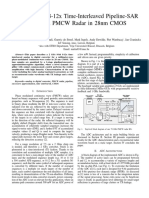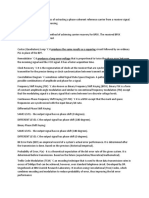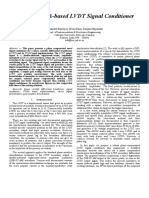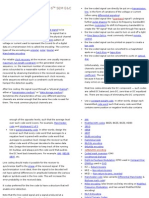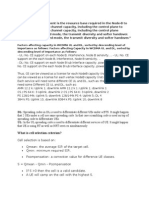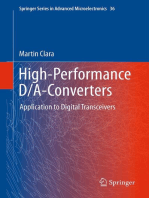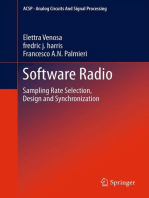CDMA: Fundamentals: The Use of A Proper Code Allows Spreading Transmitted Signal and Despreading Received Signal
CDMA: Fundamentals: The Use of A Proper Code Allows Spreading Transmitted Signal and Despreading Received Signal
Uploaded by
GehendraSubediCopyright:
Available Formats
CDMA: Fundamentals: The Use of A Proper Code Allows Spreading Transmitted Signal and Despreading Received Signal
CDMA: Fundamentals: The Use of A Proper Code Allows Spreading Transmitted Signal and Despreading Received Signal
Uploaded by
GehendraSubediOriginal Description:
Original Title
Copyright
Available Formats
Share this document
Did you find this document useful?
Is this content inappropriate?
Copyright:
Available Formats
CDMA: Fundamentals: The Use of A Proper Code Allows Spreading Transmitted Signal and Despreading Received Signal
CDMA: Fundamentals: The Use of A Proper Code Allows Spreading Transmitted Signal and Despreading Received Signal
Uploaded by
GehendraSubediCopyright:
Available Formats
CDMA: fundamentals
10 kHz bandwidth 1.25 MHz bandwidth 1.25 MHz bandwidth 1.25 MHz bandwidth 1.25 MHz bandwidth 10 kHz bandwidth
Frequency
Frequency
fc
Frequency
fc
Frequency
Frequency
Frequency
Baseband data
Encoding & Interleaving
Walsh Code Spreading
RF Section
RF Section
1.25 MHz bandwidth
Walsh Code Correlator
Decode & Deinterleaving
Baseband data
Transmitter
Background noise
Receiver
Other users Interference
fc
Frequency
fc
Frequency
The use of a proper code allows spreading transmitted signal and despreading received signal.
W-CDMA: general features
W-CDMA is designed to allow many users to efficiently share the same RF carrier by dynamically reassigning data rates and link budget to precisely match the demand of each user in the system. As its name implies, W-CDMA is a code division multiple access (CDMA) system.
As opposed to time division multiple access (TDMA), in CDMA, all users transmit at the same time. Frequency divisions are still used, but at a much larger bandwidth.
In addition, multiple users share the same frequency carrier. Each users signal uses a unique code that appears to be noise to all except the correct receiver. Therefore, the term channel describes a combination of carrier frequency and code.
W-CDMA: scrambling and channelization codes
The scrambling code (SC) provides a unique identity to each UE and each BS. The OVSF code allocations provide a unique identity to each channel conveyed by a UE or BS within one cell.
WCDMA: protocol architecture
The network layer (layer 3) is based heavily on GSM standards. It is responsible for connecting services from the network to user equipment. The RLC block is responsible for the transfer of user data, error correction, flow control, protocol error detection and recovery, and ciphering. The MAC function is responsible for mapping between logical channels and transport channels. The physical layer maps the transport channels onto the physical channels and performs all of the RF functions necessary to make the system work.
W-CDMA: basic uplink channel without complex scrambling
W-CDMA: OVSF codes
The spreading factor (SF) can be 4, 8, 16, 32, 64, 128, or 256, corresponding to DPDCH bit rates from 960kbps down to 15kbps. Seven sets of spreading codes are specified, one set for each spreading factor. Each code is denoted by Cch,SF,n. For example, Cch,4,2 means channelization code, SF = 4, code number 2.
W-CDMA: basic uplink channel with complex scrambling
W-CDMA: complex scrambling
I I chip Is Q chip Qs Q I chip Qs Is Q chip I jQ (I chip Is Q chip Qs ) j (I chip Qs Is Q chip ) (Ichip jQ chip ) (Is jQ s ) A chipA s e
j(chip s )
W-CDMA: complex scrambling
What kind of constellation does it result if complex scrambling is applied?
W-CDMA: complex scrambling
In the case of two channels with the same amplitude, the chip signal maps onto a QPSK constellation. The scrambling signal also maps onto a QPSK constellation.
W-CDMA: complex scrambling
In the case of two channels with different amplitudes, the chip signal maps onto a rectangular 4-QAM constellation. The scrambling signal still corresponds to a QPSK constellation.
W-CDMA: HPSK modulation
W-CDMA systems use Hybrid Phase Shift Keying (HPSK), also known as Orthogonal Complex Quadrature Phase Shift Keying (OCQPSK), to reduce the peakto-average power ratio of the signal in the uplink.
HPSK is a variation of basic complex scrambling that eliminates zero-crossings for every second chip point. It accomplishes this by using a specific repeating sequence as the scrambling signal and by choosing specific orthogonal codes to spread the different channels.
W-CDMA: HPSK modulation
The repeating Walsh rotator sequence, Is = W0 = (1,1) and Qs = W1 = (1,1), is used as the scrambling signal. Only even-numbered OVSF codes are used to spread the data from the different channels. Even numbered OVSF codes consist of pairs of identical bits. For two consecutive identical chip points, the first one is rotated by +45, and the second one by -45, which ensures that they will be 90 apart in the final constellation and the transition between them does not go through zero.
W-CDMA: HPSK modulation
Constellation without HPSK
Constellation with HPSK
W-CDMA: HPSK modulation
HPSK eliminates 0 phase shift transitions for every second chip point. A 0 phase transition occurs when two consecutive points are at the same place on the final constellation. This causes overshooting trajectory, which increases the peak-to-average power ratio of the signal. HPSK forces 90 transitions between pairs of consecutive points. This minimizes 0 phase transitions, which further reduces the peak-to-average power ratio of the signal.
W-CDMA: primary PN spreading code
A primary PN spreading (scrambling) code PN(1) is applied to the final I and Q signals to allow for identification of the mobile and correlation at the receiver.
The PN(1) sequence is the same for I and Q and it does not affect the number of 90 transitions. The PN(1) spreading code can instead be directly multiplied with the I and Q components of the scrambling signal before the complex scrambling.
W-CDMA: primary PN spreading code
The PN(1) sequence does not affect the number of 90 transitions.
W-CDMA: secondary PN spreading code
A decimated secondary PN spreading code (P) is multiplied with the Q component of the Walsh rotator, W1=(1,-1). P is a decimated version of the real chip rate sequence PN(2). P randomizes the direction of the phase rotation while keeping the phase difference of 90 between pairs of consecutive final points.
W-CDMA: secondary PN spreading code
The decimated secondary PN sequence (P) randomizes the direction of the rotation.
W-CDMA: uplink structure
W-CDMA: uplink DPCH/DPCCH coding, spreading, and scrambling.
In Band/in Channel Measurements
Modulation domain measurements Error vector
QPSK EVM
Composite EVM Symbol EVM Rho Code domain power
Modulation Domain Measurements Error Vector
The resulting constellation depends on the physical channel configuration. The constellation typically does not look like QPSK, or any other known constellation, except for some very specific channel configurations. For example, a signal with a single DPDCH (or a single DPCCH) does map onto a QPSK constellation. A signal with a DPDCH and a DPCCH at the same amplitude level maps onto a 45rotated QPSK constellation. You can use a regular EV measurement to evaluate the modulation quality of the transmitter for a single DPDCH, a single DPDCH, or a signal with both at the same amplitude level. More complex signals cannot be analyzed with this measurement.
Modulation Domain Measurements QPSK EVM
A regular QPSK EVM measurement can be used to evaluate the modulation quality of the transmitter for a single DPDCH, a single DPDCH, or a signal with both at the same amplitude level. More complex signals cannot be analyzed with this measurement. QPSK EVM compares the measured chip signal at the RF with an ideal QPSK reference.
Modulation Domain Measurements Composite EVM
The composite EVM is useful throughout the development, performance verification, and manufacturing phases of the UE life cycle. It in particular allows the: evaluation of the quality of the transmitter for a multi-channel signal. detection of spreading or scrambling errors. detection certain problems between the baseband and RF sections. analysis of errors that cause high interference in the signal.
Modulation Domain Measurements Symbol EVM
By descrambling and despreading the signal the constellation and EVM for a specific code channel at the symbol level, even in the presence of multiple codes, can be analyzed.
Misurazioni in Banda/nel Canale
Dominio della modulazione
Rho (r) obiettivo: valutare la qualit di modulazioni numeriche a
divisione di codice (CDMA); definizione: rapporto tra la potenza correlata e la potenza complessiva del segnale in banda base trasmesso, caratterizzato da un solo codice (un solo canale); procedura: la potenza correlata calcolata rimuovendo gli offset in frequenza, in fase e nel tempo e calcolando, in banda base, la mutua correlazione fra il segnale misurato e quello di riferimento (ideale); strumentazione: VSA, analizzatore di spettro dotato di specifica measurement personality.
Misurazioni in Banda/nel Canale
Rho (r)
r
potenza correlata potenza complessiva
Il valore di rho tanto pi elevato quanto maggiore il grado di somiglianza tra il segnale trasmesso e quello ideale. Poich la potenza non correlata si manifesta come interferenza, bassi valori di rho compromettono la capacit di una cella nei sistemi radiomobili.
Misurazioni in Banda/nel Canale
Dominio della modulazione
Potenza nel dominio dei codici obiettivo:
verificare se la stazione base sta trasmettendo la potenza prevista sui canali attivi (differenti codici) oppure sta trasmettendo anche sui canali inattivi, generando interferenza con altri utenti; definizione: potenze associate alle diverse componenti (caratterizzate da diversi codici) di un segnale in banda base in modulazione CDMA; procedura: le diverse componenti in banda base sono separate sfruttando lortogonalit tra i codici; strumentazione: VSA, analizzatore di spettro dotato di specifica measurement personality.
Misurazioni in Banda/nel Canale
Potenza nel dominio dei codici
La potenza associata ai vari canali pu essere valutata solo dopo la loro decodifica.
In Band/out of Channel Measurements
ACLR is a measure of transmitter performance. It is defined as the ratio of the transmitted power to the power measured after a receiver filter in the adjacent RF channel. This is what was formerly called adjacent channel power ratio. ACS is a measure of receiver performance. It is defined as the ratio of the receiver filter attenuation on the assigned channel frequency to the receiver filter attenuation on the adjacent channel frequency. ACIR is a measure of overall system performance. It is defined as the ratio of the total power transmitted from a source (BS or UE) to the total interference power resulting from both transmitter and receiver imperfections affecting a victim receiver.
The following relation holds
You might also like
- Using Complete Sentences Written in Your Own Words, Explain The Meaning of The FollowingDocument6 pagesUsing Complete Sentences Written in Your Own Words, Explain The Meaning of The FollowingVIKRAM KUMARNo ratings yet
- Automated Broad and Narrow Band Impedance Matching for RF and Microwave CircuitsFrom EverandAutomated Broad and Narrow Band Impedance Matching for RF and Microwave CircuitsNo ratings yet
- Comunicaciones Digitales Avanzadas DEBER 1 (Select Max. 10 Problems and Answer The Two Questions)Document3 pagesComunicaciones Digitales Avanzadas DEBER 1 (Select Max. 10 Problems and Answer The Two Questions)Cristian Sancho LopezNo ratings yet
- RRU5901 Description (AWS 4x40)Document36 pagesRRU5901 Description (AWS 4x40)Frank Saavedra Reyes100% (2)
- WCDMADocument31 pagesWCDMAHasbyNasrullohNo ratings yet
- ModulationPaper ACIQR-3Document85 pagesModulationPaper ACIQR-3Ryan AnchetaNo ratings yet
- CDMA OverviewDocument65 pagesCDMA OverviewRaghavLambaNo ratings yet
- MTDCC103 ModelAnswerDocument8 pagesMTDCC103 ModelAnswerNoman Ali35No ratings yet
- 3G Technology StudyDocument9 pages3G Technology StudyAbhay SharmaNo ratings yet
- Amplitude Modulation of PSK Project ReportDocument6 pagesAmplitude Modulation of PSK Project ReportEngr Muhammad Imran100% (2)
- EC6501 - Unit 4 & 5Document13 pagesEC6501 - Unit 4 & 5menakadevieceNo ratings yet
- 01 CDMA ConceptDocument53 pages01 CDMA ConceptSiraj SidhikNo ratings yet
- Digital Communication RecordDocument46 pagesDigital Communication Recordathavan12tc08No ratings yet
- A Survey On Digital Modulation Techniques For Software Defined Radio ApplicationsDocument8 pagesA Survey On Digital Modulation Techniques For Software Defined Radio Applicationssreekanthreddy peramNo ratings yet
- RF System Issues Related To CDMA RX SpecsDocument6 pagesRF System Issues Related To CDMA RX SpecsA. VillaNo ratings yet
- Cdma EnggDocument59 pagesCdma EnggMakarand DereNo ratings yet
- A 2GS/s 9-Bit 8-12x Time-Interleaved Pipeline-SAR ADC For A PMCW Radar in 28nm CMOSDocument4 pagesA 2GS/s 9-Bit 8-12x Time-Interleaved Pipeline-SAR ADC For A PMCW Radar in 28nm CMOSburakgonenNo ratings yet
- (VTUWORLD - Com) Advanced Communication LabDocument51 pages(VTUWORLD - Com) Advanced Communication LabKirthi RkNo ratings yet
- Carrier RecoveryDocument4 pagesCarrier RecoveryYsrael M. TatlonghariNo ratings yet
- International Journal of Electronics and Communications (AEÜ)Document10 pagesInternational Journal of Electronics and Communications (AEÜ)Numan KayaNo ratings yet
- Line Coding Techniques 2023Document31 pagesLine Coding Techniques 2023Gerald KapinguraNo ratings yet
- Digital CW Modulation Techniques: by Mrs. Leena MehtaDocument16 pagesDigital CW Modulation Techniques: by Mrs. Leena MehtaLeena Rohan MehtaNo ratings yet
- Chapter Goals: Wireless TechnologiesDocument42 pagesChapter Goals: Wireless TechnologiesabavoNo ratings yet
- Carrierless Single and Multicarrier Uwb Radio TechnologyDocument5 pagesCarrierless Single and Multicarrier Uwb Radio TechnologyJyoti AgrawalNo ratings yet
- A Novel FPGA-based LVDT Signal Conditioner: Kumardeb Banerjee, Bivas Dam, Kalyan MajumdarDocument6 pagesA Novel FPGA-based LVDT Signal Conditioner: Kumardeb Banerjee, Bivas Dam, Kalyan MajumdarnarayanNo ratings yet
- TIA IS-95 CDMA System: Downlink (Forward) (BS To MS)Document3 pagesTIA IS-95 CDMA System: Downlink (Forward) (BS To MS)Nishat ShaikhNo ratings yet
- Performance Evaluation of Ds-Cdma System Using MatlabDocument13 pagesPerformance Evaluation of Ds-Cdma System Using MatlabMuhammad FirdausNo ratings yet
- Radio Frequency Analysis Design (101 125)Document25 pagesRadio Frequency Analysis Design (101 125)Erdem ErdemNo ratings yet
- Chapter 4 ModulationDocument53 pagesChapter 4 ModulationAbdurezak ShifaNo ratings yet
- Analog and Digital CommunicationDocument15 pagesAnalog and Digital CommunicationEASACOLLEGENo ratings yet
- LTE Data Rate CalculationDocument72 pagesLTE Data Rate Calculationarslan arifNo ratings yet
- Ask & PSK: Generation and Detection: Date Expt NoDocument6 pagesAsk & PSK: Generation and Detection: Date Expt NoRajesh EceNo ratings yet
- VivaDocument31 pagesVivaRahul KumarNo ratings yet
- Cellular Comm Ec3036 Notes Module 56 2022Document31 pagesCellular Comm Ec3036 Notes Module 56 20224052-SRINJAY PAL-No ratings yet
- Cdma Tecnology: Presented byDocument49 pagesCdma Tecnology: Presented byAgni Kumar MohanandaNo ratings yet
- 06ECL67 - Advanced Communication Lab ManualDocument51 pages06ECL67 - Advanced Communication Lab ManualNaveen Kumar0% (1)
- CH 3Document20 pagesCH 3mohamed ameeNo ratings yet
- Presentation 15Document30 pagesPresentation 15Aya Abd ElmonaemNo ratings yet
- Preboard EST 2ndbatch April2015 SetBDocument15 pagesPreboard EST 2ndbatch April2015 SetBGeorge Ezar N. Quiriado100% (1)
- Line CodingDocument66 pagesLine CodingDeepak SalianNo ratings yet
- BER of OFDM System Using Concatenated Forward Error Correcting Codes (FEC) Over Nakagami-M Fading ChannelDocument5 pagesBER of OFDM System Using Concatenated Forward Error Correcting Codes (FEC) Over Nakagami-M Fading Channelseventhsensegroup100% (1)
- WC Unit-3Document8 pagesWC Unit-3dr.omprakash.itNo ratings yet
- WCDMA Optimization Related Questions - M'COM AcademyDocument13 pagesWCDMA Optimization Related Questions - M'COM Academymaddy100% (1)
- Matlab Code For MtechDocument47 pagesMatlab Code For MtechSangha MithraNo ratings yet
- PSD of Pulse Coding Techniques With MatlabDocument7 pagesPSD of Pulse Coding Techniques With MatlabNithin MukeshNo ratings yet
- Peak-To-Average Power Ratio Reduction by CB-ACE and Adaptive Ace AlgorithmsDocument8 pagesPeak-To-Average Power Ratio Reduction by CB-ACE and Adaptive Ace AlgorithmsShankar GaneshNo ratings yet
- CE (Channel Element) in WCDMADocument19 pagesCE (Channel Element) in WCDMAKausik RaychaudhuriNo ratings yet
- Line EncodingDocument6 pagesLine EncodingEgbert EncarguezNo ratings yet
- Chap 3Document4 pagesChap 3keane1100% (2)
- Cdma System Based On Is-95Document21 pagesCdma System Based On Is-95Prashanth K NNo ratings yet
- ريهام خالد جوحي PskDocument9 pagesريهام خالد جوحي Pskريهام خالد جوحيNo ratings yet
- EE 3206, Exp 05Document5 pagesEE 3206, Exp 05Tahsin Zaman TalhaNo ratings yet
- Ofdm (Orthogonal Frequency Division Multiplexing)Document28 pagesOfdm (Orthogonal Frequency Division Multiplexing)Aastha Gupta100% (1)
- Error Probability of Different Modulation Schemes For OFDM Based WLAN Standard IEEE 802.11aDocument6 pagesError Probability of Different Modulation Schemes For OFDM Based WLAN Standard IEEE 802.11aaboashoorNo ratings yet
- Channellization Code GenerationDocument60 pagesChannellization Code GenerationAsmawi MeanNo ratings yet
- High-Performance D/A-Converters: Application to Digital TransceiversFrom EverandHigh-Performance D/A-Converters: Application to Digital TransceiversNo ratings yet
- Reference Guide To Useful Electronic Circuits And Circuit Design Techniques - Part 2From EverandReference Guide To Useful Electronic Circuits And Circuit Design Techniques - Part 2No ratings yet
- Software Radio: Sampling Rate Selection, Design and SynchronizationFrom EverandSoftware Radio: Sampling Rate Selection, Design and SynchronizationNo ratings yet
- Survey Diff Revision Two Column v2 PDFDocument56 pagesSurvey Diff Revision Two Column v2 PDFbala bhaskarNo ratings yet
- CSE Anna University Chennai SyllabusDocument108 pagesCSE Anna University Chennai SyllabusAnu SelviNo ratings yet
- Eetop - CN - Digital Communication Systems Using MATLAB and SimulinkDocument679 pagesEetop - CN - Digital Communication Systems Using MATLAB and SimulinkexfmlnNo ratings yet
- Eight PSKDocument2 pagesEight PSKAnonymous tjOHUM79No ratings yet
- Training Course - 5G RAN3.0 NR Physical Channel and Signal Design V1.01Document64 pagesTraining Course - 5G RAN3.0 NR Physical Channel and Signal Design V1.01VVLNo ratings yet
- DS 2CD2421G0 IwDocument6 pagesDS 2CD2421G0 IwMurat KaraNo ratings yet
- MSM628 16 CH Mux-Scrambling QAM Modulator User ManualDocument23 pagesMSM628 16 CH Mux-Scrambling QAM Modulator User ManualJose Manuel ReyesNo ratings yet
- Huawei Hardware PDFDocument193 pagesHuawei Hardware PDFThantoe Aung100% (1)
- 1155dBTE 504Document13 pages1155dBTE 504Shubham AgrawalNo ratings yet
- Modulation and Coding Techniques M2Document74 pagesModulation and Coding Techniques M2MELJAKE ZAMORA100% (1)
- Performance Analysis of Non-Orthogonal Multiple Access Technique Using SimulinkDocument8 pagesPerformance Analysis of Non-Orthogonal Multiple Access Technique Using SimulinkWARSE JournalsNo ratings yet
- Data-Aided Frequency Estimation For Burst Digital TransmissionDocument4 pagesData-Aided Frequency Estimation For Burst Digital Transmissionqi miNo ratings yet
- BPSK Supressed Carrier NRZ Data Demodulation Using Costas Loop On Actel Microsemi FPGADocument33 pagesBPSK Supressed Carrier NRZ Data Demodulation Using Costas Loop On Actel Microsemi FPGAPrabhpreet Singh DuaNo ratings yet
- 4EC4-21 ADC Lab AS-16aDocument93 pages4EC4-21 ADC Lab AS-16aSu KoshNo ratings yet
- Performance of Multi Tone Code Division Multiple Access (MT-CDMA) in AWGN Channel and in Presence of Narrowband JammingDocument4 pagesPerformance of Multi Tone Code Division Multiple Access (MT-CDMA) in AWGN Channel and in Presence of Narrowband Jammingapi-19919509No ratings yet
- DVB S2 FactsheetDocument2 pagesDVB S2 Factsheetrosan.sapkotaNo ratings yet
- Libra BrochureDocument4 pagesLibra BrochurechebhebmgNo ratings yet
- Manual Qviart UNDRODocument178 pagesManual Qviart UNDROMANUEL RODRIGUEZ HERRERANo ratings yet
- LALALADocument2 pagesLALALADamian RattalinoNo ratings yet
- Fso RF - Out RXRDocument11 pagesFso RF - Out RXRRF_RAJANo ratings yet
- RRU5903 (850Mhz) - Technical SpecificationsDocument8 pagesRRU5903 (850Mhz) - Technical SpecificationsGuilherme Tomazoli Dias PalomoNo ratings yet
- PW0 100 FDocument192 pagesPW0 100 Fmasudrana7300No ratings yet
- 802.11ah 1Document9 pages802.11ah 1StJack123No ratings yet
- ADC Viva QsDocument3 pagesADC Viva QsRockstar_rohithNo ratings yet
- 2018 09 PPC-10G-HP FinalDocument4 pages2018 09 PPC-10G-HP FinalArman SebastianNo ratings yet
- Hyung G Myung PHD ThesisDocument150 pagesHyung G Myung PHD ThesisArdhendu TripathyNo ratings yet
- Lab ViewDocument48 pagesLab Viewsuresh270No ratings yet

















